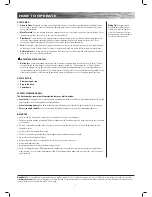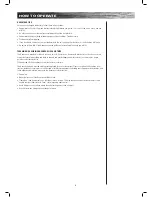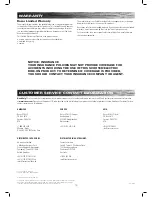
6
HOW IT WORKS
The Hovertrax responds to the rider's foot movements. Remember this. The Hovertrax moves due to fore and aft foot
platform tilt caused by the rider’s foot (or feet).
Movement, speed, and stopping are controlled by the degree to which the rider’s feet cause the foot platforms of the
Hovertrax to no longer be parallel to the ground.
When the product is “on”, the gyroscopic mechanized balancing feature of the Hovertrax tries to keep the foot platforms
of the product parallel to the ground. In use, Hovertrax then detects changes from "level" which are caused by fore
and aft pressure on the foot platform(s) applied by the rider’s feet. Such changes are interpreted by the Hovertrax as
instructions to make the wheels move. Hovertrax tries to re-level a forward tilt by accelerating, and tries to level a
rearward tilt by decelerating.
Moving and Changing Direction:
When a rider stands on the Hovertrax with an evenly weighted foot "level" on either foot platform:
• Pressing toes on both feet downward moves Hovertrax forward
• Pressing heels on both feet downward moves Hovertrax backward
• Turns are done by putting more downward pressure on the front side of the foot platform on the outside
of the turn.
• A rider can spin in place by pushing downward on the front edge of one foot platform while simultaneously
pushing downward on the rear edge of the other foot platform.
Accelerating and Stopping:
• To go faster or to slow down, press the foot platforms at a greater angle for “more” and reduce the angles
for “less”.
• When slowing or stopping, if you continue to apply force to the edges opposite the direction of travel, you may
not only stop but continue on to reverse your direction.
How does this happen? The fundamental principle is that the Hovertrax is designed to be “at rest” when the foot
platforms are level – and the gyroscopic mechanized balancing feature detects the “levelness” of the product. This
same feature detects foot movements which cause a foot platform to no longer be “level” and it interprets these
changes as orders to move.
That’s it. That’s how it works. It does what your feet tell it to do, and the product “self-balances” itself in order to be
ready to detect and implement the instructions provided by a rider’s feet.
Understanding this principle is important for obvious reasons. It also suggests some obvious warnings for riding the
Hovertrax, such as:
•
Do not jump up and down on it:
If you remove a foot (or both feet), if you then land back on the Hovertrax and
cause the foot platform(s) to change position relative to “level” in any degree, the machine could and will react by
moving immediately in response to an “instruction”, which can result in loss of rider stability, balance or control.
•
Shifting Weight Alone is not the Issue:
Do not presume that shifting weight alone controls motion – or, for
that matter, that not shifting weight equals “stability”. Shifting of rider weight may be associated with increase or
decrease of foot pressures on the foot platforms, but it is the action of the feet on the foot platforms which instructs
Hovertrax to move. Conversely, if you were to shift your weight without altering the placement or angle of your feet,
so that the foot platforms remain level, the Hovertrax does not receive any “signal” to interpret.
HOW TO GET ON
Once you have charged the battery (see page 5 for charging information):
1.
Power On:
Set the Hovertrax on the ground and turn the power on. The green light on the top of the unit will light
up. The Hovertrax can face in either direction.
2.
First Foot:
While standing behind the Hovertrax, put one foot on a foot platform, closer to the wheel than to the
center. Use that foot to activate the foot platform by bringing that foot platform to a balanced, level position.
3.
Confirm Activation:
Confirm the first foot platform is activated. Move your foot back and forth and feel the
response from the unit. Play with this single foot platform until you are comfortable keeping the foot platform
motion minimal.
4.
Step Up:
With the first foot platform stable and still, step up on the second foot platform with your second foot.
Do this away from furniture and other large objects. Don’t use a fixed object to brace or lift yourself – Keep your
weight evenly distributed between the two foot platforms. If you are uncomfortable; step back off and repeat from
step 2. Try to stand on the Hovertrax without moving.
Note:
Do not lift the Hovertrax off
the ground when it is turned on. Do
not turn on the Hovertrax in mid-air.
Riding Tip:
Before your very
first ride, expect to spend up
to ten minutes in this stage
of learning how to stand
comfortably on the Hovertrax.
Riding Tip:
Certainly the rider may
"lean" on the Hovertrax, but leaning
only affects the foot platform's
position to the extent the rider's feet
change their position. If the rider's
ankles are held at a consistent 90°
angle, leaning will result in tilting.
Note that leaning can exaggerate
shifting of weight, which may affect
the ability of a rider to recover to
a level posture – increasing the
possibility of loss of balance.
HOW TO OPERATE
Summary of Contents for HOVERTRAX
Page 2: ......






























